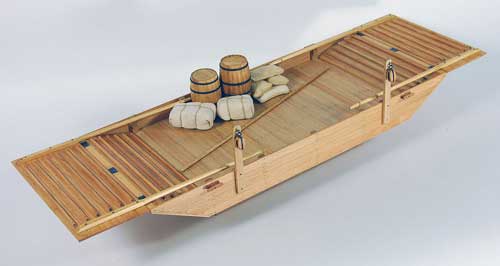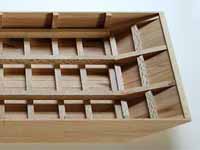> COLONIAL FERRY 2
> CRAB SCRAPING BOAT > EMMA C. BERRY > ALMA > HANNAH > LARK > CLERMONT > NANTUCKET > PINKY SCHOONER > BUYBOAT > FLATTIE > ROUND STERN > BOATSHOP DIORAMA > POWER SKIFF > DRAKETAIL > HEAD BOAT > MINI ROUND STERN > MESSENGER > STERN CUTAWAY > SHALLOP > DELAWARE > SAILING SKIFF > ROWBOATS > WRIGHT SKIFF > F.D.CROCKETT > PRINCESSKITS FOR NOVICES TOOLS TECHNIQUES MUSEUMS LINKS ABOUT METhis is the second colonial ferry model I've built. The model will be part of a permanent exhibition at The Prizery in South Boston, Virginia. The exhibit tells the story of the crossing of the Dan River at Irwin's and Boyd's ferries in Halifax County, Virginia, by General Nathanael Greene on February 14, 1781. Be sure to visit their web site to learn more.This ferry model represents the type of ferry or "flat" that might have been in use at the time.

View a larger version of the finished ferry image.
 Interior Construction |
 Ramp Underside |
The construction of this ferry is different from the first ferry I built. Where the first used carved logs for the sides, this one uses individual planks. And, where the bow sections were curved on the other ferry, they are straight on this one. All of the planks are fastened with simulated nails (about 1,000 of them). I had originally intended to use brass wire for this, but the blackening solution is blue and stains the wood. I discovered that gun bluing (which can't be used on non-ferrous metals like brass) is clear. So I was able to find some soft steel wire that would turn black with the bluing. Both sides of this ferry have iron hinges and the model is made of beech to simulate oak. |
|
 Guide-rope Block |
 Barrel Detail |
On this model, I added the supports for the guide-rope blocks to match the drawing. I also added some "cargo" for visual interest. Making the barrels was not as hard as I'd suspected it would be. I turned a core out of pine then cut individual staves out of basswood. The hoops are strips of paper painted black. It took about three hours to make each barrel but it was kind of fun. All in all, it took about 3 months to build in my spare time. Another enjoyable project that definitely put me back in the modeling mood. |
|
Copyright © 2021 - John H. Earl
All Rights Reserved.
Problems with the site? Contact the Web Master
Last Updated:
April 3, 2021

